LCD-Clock-A
| ||
Overview
Product Introduction
Programmable RGB pseudo nixie tube clock
Support Raspberry Pi Pico or Zero.
Do you know the old glory of the last century: the nixie tube?
Worried about the shutdown and short service life of the nixie tube?
This is an LCD pseudo nixie tube clock that can help you recall this punk style.
Specification
| Parameter Name | Parameters |
| Dimensions | 200mm × 80mm × 34mm |
| Weight | 430g |
| Power | 5V 2A |
| Interface | Type-C |
| LCD screen | 1.14", 135 × 240 pixels |
| Cover | Quartz glass |
| Support | Raspberry Pi Pico (with pinheader version) and Raspberry Pi Zero / Zero 2 W (not included) |
Onboard Resources
How To Assemble

Note: please download the code to the host control first, and test it before assembling!
- Step 1: Insert the host control (Raspberry Pi ZERO, pico, esp32-s2-pico) into the back of the "1" board. The pico and esp32-s2-picode USB ports are facing outwards without screws. Raspberry Pi needs (2x copper posts + 4 silver-white screws) to fix the 2 holes on the non-interface side;
- Step 2: On 1 to 2, you need to pay attention to 1. You must put the 4 buttons on the side before you can put them in. Then use the patterned copper column, first lightly lock the diagonal alignment holes, then lock the rest, and then all tightened (4 single-headed copper posts);
- Step 3: Install 3 on 2, use black screws, in the same way, first lightly lock the diagonal alignment holes, then lock the rest, and then tighten them all (4 black);
- Step 4: Insert the LCD into the 1 board, the side with the buttons is the back of the LCD, then put the glass cover, and lock it with silver-white screws (6*2 silver-white);
- Step 5: Cover 4 on top of 2, use black screws to lock the diagonally aligned holes first, then lock the rest, and then tighten them all (4 black).
Working With Raspberry Pi Zero
Please test the code first before assembling.
Install Library
#python2 sudo apt-get update sudo apt-get install python-pip sudo apt-get install python-pil sudo apt-get install python-numpy sudo pip install spidev sudo pip install rpi_ws281x #python3 sudo apt-get update sudo apt-get install python3-pip sudo apt-get install python3-pil sudo apt-get install python3-numpy sudo pip3 install spidev sudo pip3 install rpi_ws281x
Download & Test The Demo
Open the terminal of Raspberry Pi, run the following demo:
sudo apt-get install unzip -y sudo wget https://files.waveshare.com/upload/a/ae/LCD-Clock-A-Code.zip sudo unzip ./LCD-Clock-A-Code.zip -d ./LCD-Clock-A-Code/ cd LCD-Clock-A-Code/rpi/
Run The Program
Please keep it in the directory of the previous step. In order to display the time normally, please follow the steps below:
- For the first configuration, the default time of the program is the system time written into the RTC, so write the time for the first time. If the time is not correct, the system can be adjusted to the correct time or adjusted through the menu during runtime.
ls -l sudo python main.py
- Open main.py and comment the forty-second line of code:
sudo nano +42 main.py
Then enter # to comment, press ctrl+x and then press Y, and press Enter to comment.
Set Auto-start
sudo nano /etc/rc.local
Add the following before exit 0:
sudo python /home/pi/LCD-Clock-A-Code/rpi/main.py &
Note that you must add "&" to run in the background, otherwise the system may not be able to start.

Reboot the device:
sudo reboot
Demo
Directory
- menupic/: menu picture directory, built-in 2 sets of menu operation interface pictures with white background and black background;
- numpic/: digital picture directory, built-in 4 sets of digital pictures, used to display the time;
- main.py: main program;
- BME280.py: temperature, humidity, and pressure sensor driver;
- DS3231.py: RTC driver;
- Font.ttc: font file, used to display temperature and humidity;
- GPIOCFG.py: button, buzzer driver;
- __pycache__: The cache directory generated by Python3, is meaningless;
- ST7789V.py: drivers for 6 LCDs;
- WS2812.py: RGB lamp driver;
Customize Dial Plate
If you need to customize the dial plate, please open main.py:
sudo nano +18 main.py
This is the directory of digital picture files. You can change the letters after /numpic/ to four types: A, B, C, D. If you have any custom ones, please create a new directory E or other under /numpic/, code This is also changed to relevant;
Similarly, the custom menu is the same, change the code line 19.

Resource
Document
ESP32
Program
Software
Development Software
- Zimo221.7z
- Image2Lcd.7z
- Font Library Tutorial
- Image Extraction Tutorial
- Thonny Python IDE (Windows V3.3.3)
Pico Getting Started
Firmware Download
Introduction
MicroPython Series
Install Thonny IDE
In order to facilitate the development of Pico/Pico2 boards using MicroPython on a computer, it is recommended to download the Thonny IDE
- Download Thonny IDE and follow the steps to install, the installation packages are all Windows versions, please refer to Thonny's official website for other versions
- After installation, the language and motherboard environment need to be configured for the first use. Since we are using Pico/Pico2, pay attention to selecting the Raspberry Pi option for the motherboard environment
- Configure MicroPython environment and choose Pico/Pico2 port
- Connect Pico/Pico2 to your computer first, and in the lower right corner of Thonny left-click on the configuration environment option --> select Configture interpreter
- In the pop-up window, select MicroPython (Raspberry Pi Pico), and choose the corresponding port
Flash Firmware
- Click OK to return to the Thonny main interface, download the corresponding firmware library and burn it to the device, and then click the Stop button to display the current environment in the Shell window
- Note: Flashing the Pico2 firmware provided by Micropython may cause the device to be unrecognized, please use the firmware below or in the package
- How to download the firmware library for Pico/Pico2 in windows: After holding down the BOOT button and connecting to the computer, release the BOOT button, a removable disk will appear on the computer, copy the firmware library into it
- How to download the firmware library for RP2040/RP2350 in windows: After connecting to the computer, press the BOOT key and the RESET key at the same time, release the RESET key first and then release the BOOT key, a removable disk will appear on the computer, copy the firmware library into it (you can also use the Pico/Pico2 method)
MicroPython Series
【MicroPython】 machine.Pin class function details
【MicroPython】machine.PWM class function details
【MicroPython】machine.ADC class function details
【MicroPython】machine.UART class function details
【MicroPython】machine.I2C class function details
【MicroPython】machine.SPI class function details
【MicroPython】rp2.StateMachine class function details
C/C++ Series
For C/C++, it is recommended to use Pico VS Code for development. This is a Microsoft Visual Studio Code extension designed to make it easier for you to create, develop, and debug projects for the Raspberry Pi Pico series development boards. No matter if you are a beginner or an experienced professional, this tool can assist you in developing Pico with confidence and ease. Here's how to install and use the extension.
- Official website tutorial: https://www.raspberrypi.com/news/pico-vscode-extension/
- This tutorial is suitable for Raspberry Pi Pico, Pico2 and the RP2040 and RP2350 series development boards developed by Waveshare
- The development environment defaults to Windows11. For other environments, please refer to the official tutorial for installation
Install VSCode
-
First, click to download pico-vscode package, unzip and open the package, double-click to install VSCode
Note: If vscode is installed, check if the version is v1.87.0 or later
Install Extension
-
Click Extensions and select Install from VSIX
-
Select the package with the vsix suffix and click Install
-
Then vscode will automatically install raspberry-pi-pico and its dependency extensions, you can click Refresh to check the installation progress
-
The text in the right lower corner shows that the installation is complete. Close VSCode
Configure Extension
-
Open directory C:\Users\username and copy the entire .pico-sdk to that directory
-
The Copy is completed
-
Open vscode and configure the paths for the Raspberry Pi Pico extensions
The configuration is as follows:Cmake Path: ${HOME}/.pico-sdk/cmake/v3.28.6/bin/cmake.exe Git Path: ${HOME}/.pico-sdk/git/cmd/git.exe Ninja Path: ${HOME}/.pico-sdk/ninja/v1.12.1/ninja.exe Python3 Path: ${HOME}/.pico-sdk/python/3.12.1/python.exe
New Project
-
The configuration is complete, create a new project, enter the project name, select the path, and click Create to create the project
To test the official example, you can click on the Example next to the project name to select
-
The project is created successfully
-
Select the SDK version
-
Select Yes for advanced configuration
-
Choose the cross-compilation chain, 13.2.Rel1 is applicable for ARM cores, RISCV.13.3 is applicable for RISCV cores. You can select either based on your requirements
-
Select default for CMake version (the path configured earlier)
-
Select default for Ninjaversion
-
Select the development board
-
Click Complie to compile
-
The uf2 format file is successfully compiled
Import Project
- The Cmake file of the imported project cannot have Chinese (including comments), otherwise the import may fail
-
To import your own project, you need to add a line of code to the Cmake file to switch between pico and pico2 normally, otherwise even if pico2 is selected, the compiled firmware will still be suitable for pico
set(PICO_BOARD pico CACHE STRING "Board type")
Update Extension
-
The extension version in the offline package is 0.15.2, and you can also choose to update to the latest version after the installation is complete
Arduino IDE Series
Install Arduino IDE
-
First, go to Arduino official website to download the installation package of the Arduino IDE.

-
Here, you can select Just Download.

-
Once the download is complete, click Install.

Notice: During the installation process, it will prompt you to install the driver, just click Install
600px
Arduino IDE Interface
-
After the first installation, when you open the Arduino IDE, it will be in English. You can switch to other languages in File --> Preferences, or continue using the English interface.

-
In the Language field, select the language you want to switch to, and click OK.

Install Arduino-Pico Core in the Arduino IDE
-
Open the Arduino IDE, click on the file in the top left corner, and select Preferences
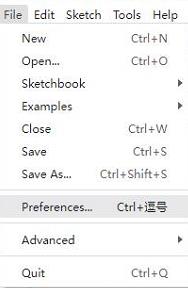
-
Add the following link to the attached board manager URL, and then click OK
https://github.com/earlephilhower/arduino-pico/releases/download/4.0.2/package_rp2040_index.json
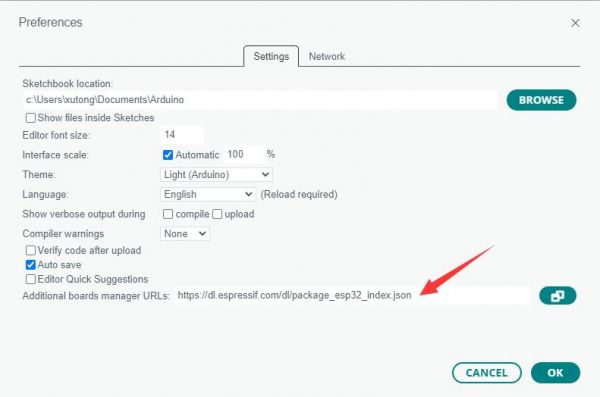
Note: If you already have an ESP32 board URL, you can use a comma to separate the URLs as follows:https://dl.espressif.com/dl/package_esp32_index.json,https://github.com/earlephilhower/arduino-pico/releases/download/4.0.2/package_rp2040_index.json
-
Click Tools > Development Board > Board Manager > Search pico, as my computer has already been installed, it shows that it is installed
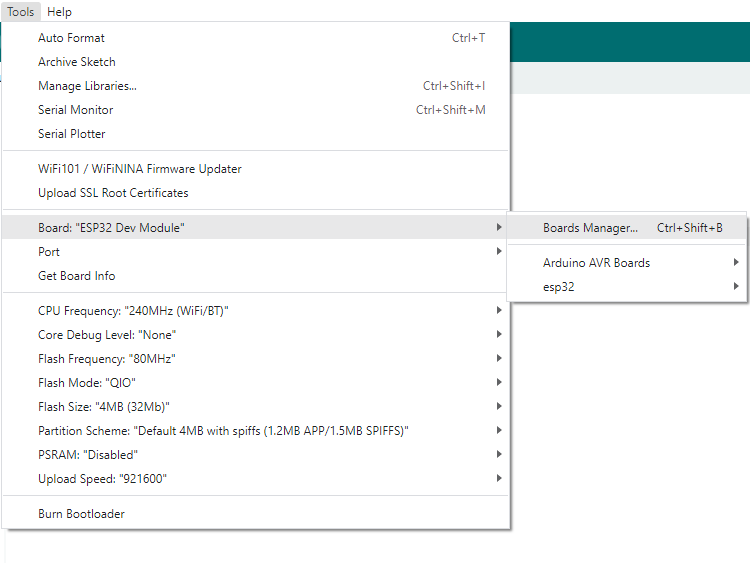
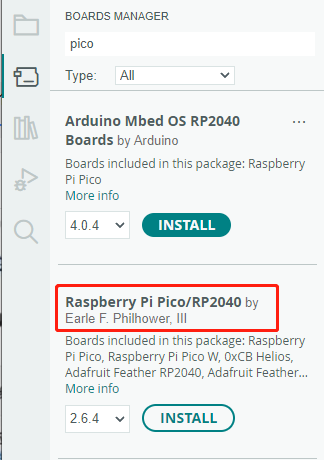
Upload Demo at the First Time
-
Press and hold the BOOTSET button on the Pico board, connect the pico to the USB port of the computer via the Micro USB cable, and release the button after the computer recognizes a removable hard disk (RPI-RP2).
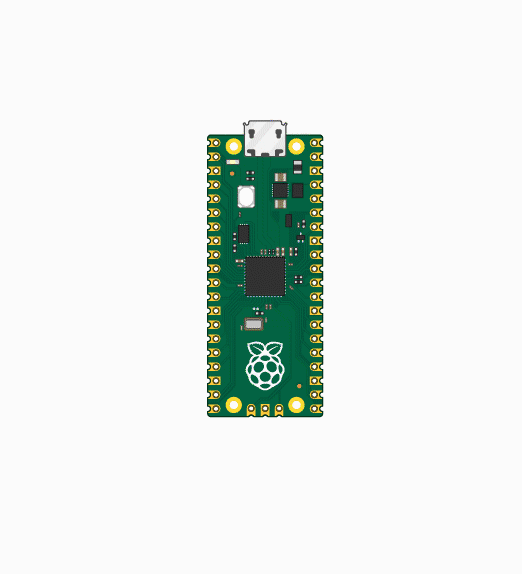
- Download the program and open D1-LED.ino under the arduino\PWM\D1-LED path
-
Click Tools --> Port, remember the existing COM, do not click this COM (the COM displayed is different on different computers, remember the COM on your own computer)
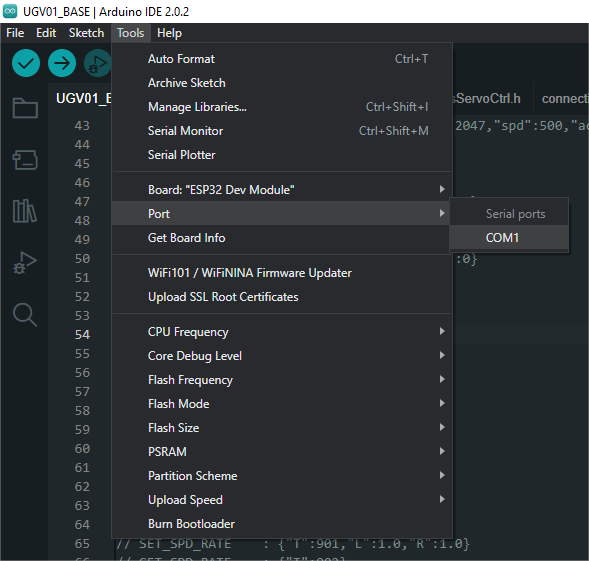
-
Connect the driver board to the computer using a USB cable. Then, go to Tools > Port. For the first connection, select uf2 Board. After uploading, when you connect again, an additional COM port will appear
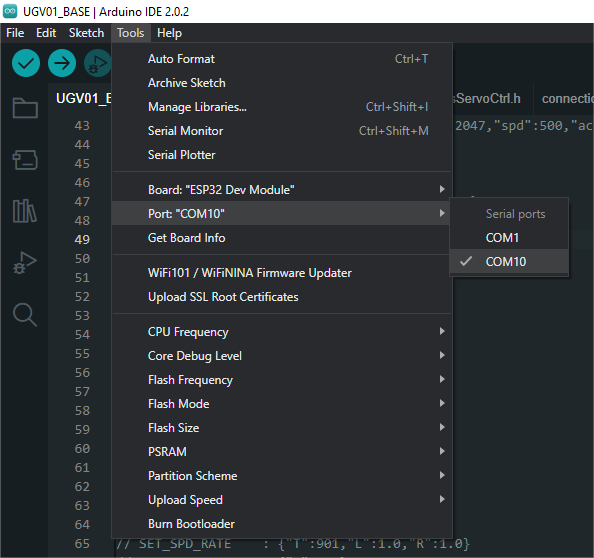
-
Click Tools > Development Board > Raspberry Pi Pico > Raspberry Pi Pico or Raspberry Pi Pico 2
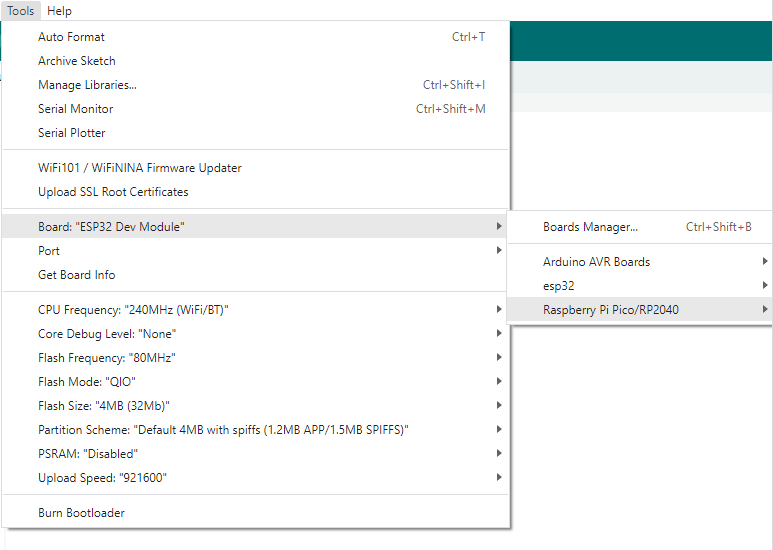
- After setting it up, click the right arrow to upload the program

- If issues arise during this period, and if you need to reinstall or update the Arduino IDE version, it is necessary to uninstall the Arduino IDE completely. After uninstalling the software, you need to manually delete all contents within the C:\Users\[name]\AppData\Local\Arduino15 folder (you need to show hidden files to see this folder). Then, proceed with a fresh installation.
Open Source Demos
MircoPython video demo (github)
MicroPython firmware/Blink demos (C)
Raspberry Pi official C/C++ demo (github)
Raspberry Pi official micropython demo (github)
Arduino official C/C++ demo (github)
FAQ
You need to enable I2C and SPI communication on your Raspberry Pi board.
Enable I2C:
Configure your Pi and enable the I2C:
sudo raspi-config
Select Advanced Options -> I2C -> <YES> to enable the I2C driver by kernel. Then you can check if the I2C is enabled.
Enable SPI:
Configure your Pi and enable the SPI
sudo raspi-config
Select Advanced Options -> SPI -> <YES> to enable the SPI driver by kernel. Then you can check if the SPI is enabled.
https://www.raspberrypi.com/documentation/computers/configuration.html
{{{5}}}
3V CR1220 cell battery.
{{{5}}}
Support
Technical Support
If you need technical support or have any feedback/review, please click the Submit Now button to submit a ticket, Our support team will check and reply to you within 1 to 2 working days. Please be patient as we make every effort to help you to resolve the issue.
Working Time: 9 AM - 6 PM GMT+8 (Monday to Friday)










